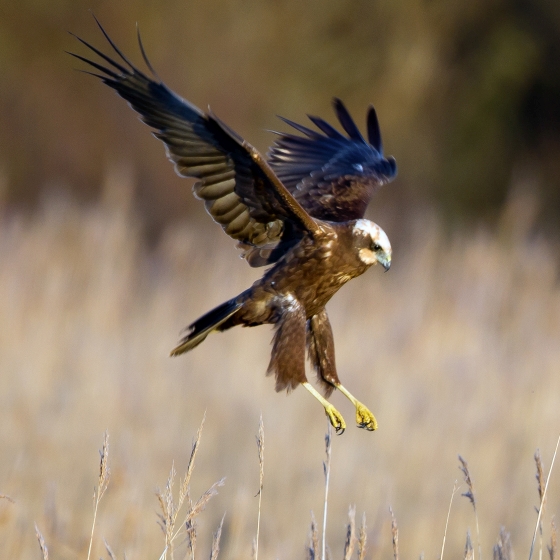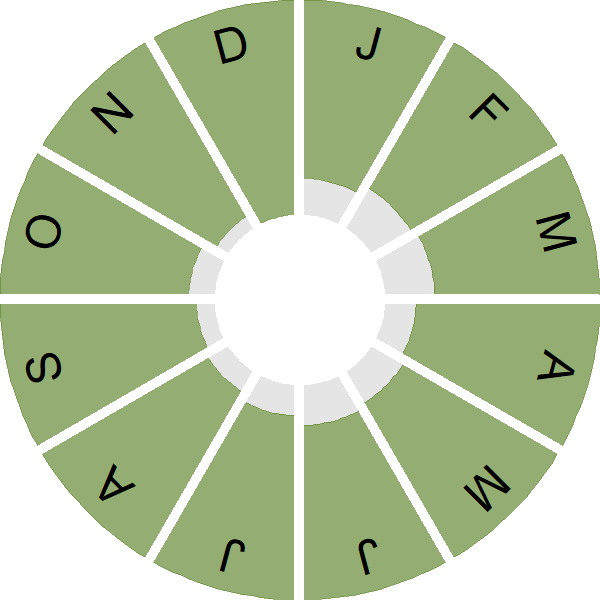Marsh Harrier

Introduction
Seen gliding above reedbeds on broad and slightly raised wings, the Marsh Harrier has become an increasingly common sight, mainly in eastern England.
The Marsh Harrier is a large and bulky bird of prey that feeds on small waterbirds and mammals, caught in the marshes around our eastern coasts. Made extinct in Britain by persecution in the 19th century, the current population has grown from a single breeding group in Suffolk in 1971.
In the last fifty years, the species has doubled the extent of its breeding range, extending north and west with occasional pairs reaching Scotland.

Key Stats
Identification
Songs and Calls
Call:
Status and Trends
Conservation Status
Population Change
Marsh Harriers became extinct in the UK in 1899 before recolonising from 1927 onwards; the population in the UK peaked at 15 nests in 1958 but then declined again and reached a low point of just one pair in 1971 (Underhill-Day 1998). It has since increased strongly with a mean of just over 400 breeding pairs reported to the RBBP over the five years 2015–2019 (Eaton et al. 2021). There has been a corresponding expansion in distribution with breeding birds now widely spread across Britain although its strongholds remain in the east of England (Balmer et al. 2013). It is now sufficiently widespread to enable short-term BBS trends to be calculated; these show a 36% increase over the most recent 10 year period for which results are available (2008–18) (Harris et al. 2020).
Distribution
Breeding Marsh Harriers are concentrated in eastern England, but with small outlying populations in the north west and in Scotland, and have recently bred in Northern Ireland for the first time in over 100 years. In winter they are present in many coastal parts of southern and eastern England, and coastal Wales, plus some inland areas such as the Fens and Somerset Levels.
Occupied 10-km squares in UK
2007/08–10/11
or view it on Bird Atlas Mapstore.
2008–11
or view it on Bird Atlas Mapstore.
European Distribution Map
Distribution Change
The breeding range of the Marsh Harrier has more than doubled since the early 1990s.
Change in occupied 10-km squares in the UK
from 1981–84 to 2007–11
or view it on Bird Atlas Mapstore.
from 1968–72 to 2008–11
or view it on Bird Atlas Mapstore.
Seasonality
Marsh Harriers were formerly summer visitors but are now recorded consistently year-round.
Weekly pattern of occurrence
The graph shows when the species is present in the UK, with taller bars indicating a higher likelihood of encountering the species in appropriate regions and habitats.

Movement
Britain & Ireland movement
Foreign locations of birds ringed or recovered in Britain & Ireland
Dots show the foreign destinations of birds ringed in Britain & Ireland, and the origins of birds ringed overseas that were subsequently recaptured, resighted or found dead in Britain & Ireland. Dot colours indicate the time of year that the species was present at the location.
- Winter (Nov-Feb)
- Spring (Mar-Apr)
- Summer (May-Jul)
- Autumn (Aug-Oct)

European movements
EuroBirdPortal uses birdwatcher's records, such as those logged in BirdTrack to map the flows of birds as they arrive and depart Europe. See maps for this species here.
The Eurasian-African Migration Atlas shows movements of individual birds ringed or recovered in Europe. See maps for this species here.
Biology
Productivity and Nesting
Nesting timing
Egg measurements
Clutch Size
Survival and Longevity
Survival is shown as the proportion of birds surviving from one year to the next and is derived from bird ringing data. It can also be used to estimate how long birds typically live.
View number ringed each year in the Online Ringing Report.
Lifespan
Survival of adults
Survival of juveniles
Biometrics
Wing length and body weights are from live birds (source).
Ring Size
Classification, names and codes
Classification and Codes
- Order: Accipitriformes
- Family: Accipitridae
- Scientific name: Circus aeruginosus
- Authority: Linnaeus, 1758
- BTO 2-letter code: MR
- BTO 5-letter code: MARHA
- Euring code number: 2600
Alternate species names
- Catalan: arpella comuna
- Czech: moták pochop
- Danish: Rørhøg
- Dutch: Bruine Kiekendief
- Estonian: roo-loorkull
- Finnish: ruskosuohaukka
- French: Busard des roseaux
- Gaelic: Clamhan-lòin
- German: Rohrweihe
- Hungarian: barna rétihéja
- Icelandic: Brúnheiðir
- Irish: Cromán Móna
- Italian: Falco di palude
- Latvian: niedru lija
- Lithuanian: nendrine linge
- Norwegian: Sivhauk
- Polish: blotniak stawowy
- Portuguese: águia-sapeira
- Slovak: kana mociarna
- Slovenian: rjavi lunj
- Spanish: Aguilucho lagunero occidental
- Swedish: brun kärrhök
- Welsh: Boda'r Gwerni
- English folkname(s): Duck Hawk, Moor Buzzard
Research
Causes of Change and Solutions
Causes of change
The restoration and re-creation of reedbed habitats for conservation of reedbed specialists is likely to have helped Marsh Harriers, although nesting in arable fields has also been important in the recent recovery (Underhill-Day 1998). Other factors which may also have contributed to the increases include the ban on organochlorine pesticide use and reduced persecution from humans (Underhill-Day 1998).
More Evidence
More evidence from Conservation Evidence.com
Partners
Citing BirdFacts
If you wish to cite particular content in this page (e.g. a specific value) it is best to use the original sources as linked in the page. For a more general citation of the whole page please use: BTO (20XX) BirdFacts Species: profiles of birds occurring in the United Kingdom. BTO, Thetford (www.bto.org/birdfacts, accessed on xx/xx/xxxx).

